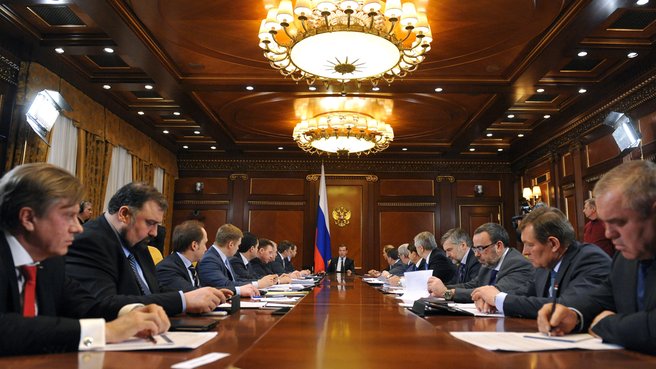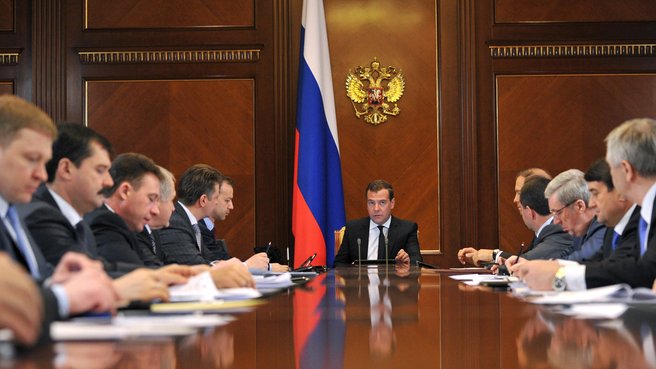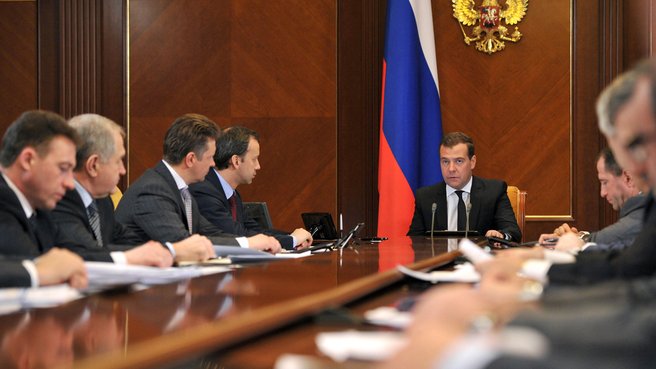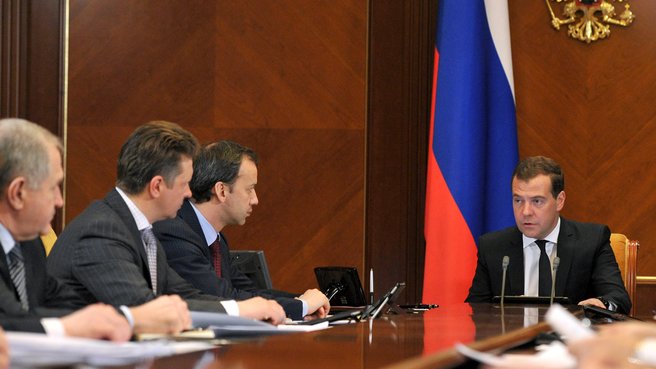Transcript:
Dmitry Medvedev: Today we return to discussing the issue of regional aviation, but of course, in the context of improving the accessibility of transport services across Russia. We have included the highly ambitious goal of increasing people’s mobility by 40% in the Government Policy Priorities we adopted.
Air transport understandably plays a key role in these plans. In many Russian regions, there are simply no other possibilities for reaching a required destination, a problem that railways or motor roads are unlikely to solve any time soon.
We already discussed the industry’s problems and potential solutions in Novosibirsk last August when we approved the so-called roadmap for regional air transport development. This year, the Government has allocated 3.5 billion roubles to provide for air service between European Russia and the Far East and Siberia. About 500 million roubles have been allocated to subsidise air transport to Kaliningrad during the peak season for all groups of passengers. Federal Government-financed enterprises have been established at several airports in the Far North and other remote areas. About 3 billion roubles were allocated in the form of subsidies for these enterprises in 2013, and another 2 billion will be provided to renew their aircraft fleet. At the same time, according to estimates, the costs of airport and navigation services for regional flights are much higher than those for long-range flights, in some cases up to 400%.
Therefore, it is the shared responsibility of the federal and regional governments and air carriers to work out a list of the most popular routes and ensure regular flights and affordable fares.
We have launched a project in the Volga Federal District to develop local air services, which involves more than 100 destinations as far as I know. Is that right? (addressing Mikhail Babich)
Mikhail Babich (Presidential envoy to the Volga Federal District): There are 114 destinations.
Dmitry Medvedev: The federal Government has allocated 300 million roubles to support the project, and regional budgets will provide proportionate co-financing. Special economy class fares will apply from April 1 through November 30.
The air carriers that will be selected for the project will have the largest aggregate frequency of flights and the largest number of Russian-made aircraft to be used for these flights.
This work needs to be based on a thorough and detailed study of the Russian market as well as an analysis of the best international practices and solid methodological support.
I have issued some orders and would like to hear your reports on the progress. Let’s discuss in more detail the implementation of the Volga project, considering that it is meant to become a pilot project for a new model of subsidising routes in other federal districts as well. The subject is clear. Mr Sokolov, take the floor please.
Maxim Sokolov (Transport Minister): Thank you, Mr Medvedev. Passenger air travel in this country has been developing steadily and three times quicker than the world average. Last year our airlines carried 74 million passengers, which represented a 15.4% increase in the number of passengers and over 18% growth in passenger-kilometres. World air traffic grew a mere 5%.
Our airlines carried 33.4 million passengers on domestic flights – about 45% of all flights by Russian airlines. This was a smaller increase, 8.2%, compared to 2011. A little over 4.76 million passengers were carried between regions, excluding direct routes to Moscow and St Petersburg. The growth in such flights was even less, but still 3.7% relative to 2011. This shows how small domestic flight segment is.
Next slide, please. The average cost of air travel on regional and local airlines in terms of seat-kilometres is several times higher than on long-range flights. It is about 2.5 roubles on long-range flights, five roubles on regional flights and 35 roubles on local ones. Moreover, the average price of air tickets…
Dmitry Medvedev: Is it for one kilometre? How is it measured?
Maxim Sokolov: Yes, the average cost for a kilometre. The high cost – 35 roubles – is due to the use of helicopters for local flights, which is much more expensive. Moreover, the average price of tickets for regional and local airlines (you can see it on the slide) is 20%, in some cases 40% and even 45% higher than in the United States and Canada, which are similar to this country in terms of territory and conditions. This shows that our airlines, primarily local ones, have low fuel efficiency and high operating costs for their fleet.
The average return economy fare on our regional airlines is 23,200 roubles. This is almost equal to the average monthly salary of our population. According to the Rosstat (Federal State Statistics Service), last year the average monthly salary was 26,350 roubles. Overseas, the price of a return ticket on regional airlines is no more than 5% of the average monthly salary.
We have 1,305 domestic regional air routes (next slide, please), including 121 routes that are linked with Moscow and St Petersburg. I’d like to mention for comparison’s sake that in 1990 we had almost 5,000 domestic routes. Practically 90% of passengers on these routes travel to Moscow and St Petersburg.
At last year’s meeting in Novosibirsk, you issued several directives. I would like to report on progress in developing regional air transport over this period. First, we have created a standing working group for regional air transport under the Government Commission on Transport, which includes members representing the business community, airports, the Ministry of Transport, the Federal Agency for Air Transport, and other federal executive authorities. Jointly with the relevant federal authorities and air carriers, the Ministry of Transport developed the road map, Expanding Air Transport, which was approved by the Government. The road map includes 18 actions, five of which have been performed, and the rest are in various stages of implementation. Next slide, please.
The road map outlines benchmarks according to which domestic airlines will carry 45 million passengers in 2015 and regional airlines 6.7 million passengers; the air mobility ratio will increase to 0.6; and the number of regional routes will total 1,500. You can see here how this market segment will grow relative to 2012.
In addition, the Government has approved the action plan...
Dmitry Medvedev: Do I understand correctly, that you plan to increase the domestic air traffic by 50% by 2015, and by 150% by 2020?
Maxim Sokolov: Yes, compared with the current numbers...
Dmitry Medvedev: The current period.
Maxim Sokolov: Correct. The only thing is that the road map was adopted in late 2012, and the estimated figure shown in the map is slightly lower than the actual volume of traffic. However, in general, these are valid projections.
The analysis performed by the Federal Antimonopoly Service shows that one additional air carrier reduces the air fare by up to 30% on any given route. This and other measures are likewise included in the Government approved plan, Promoting Competition and Improving Antimonopoly Policies, which covers the air transport industry. We believe that once implemented, these measures will significantly improve airlines’ efficiency, promote competition and open the door to future growth.
I would like to focus on the most important events and results achieved during the reporting period. We are implementing seven state support programmes, some of which you have already mentioned, so I’ll briefly go over the remaining ones. The programmes in question include subsidising federal state-owned enterprises established at regional and local airports and subsidising selected air fields in the Far North and similar areas. These programmes will be carried out in a more thorough manner if these enterprises are given the status of state-owned entities. Then there’s subsidising passenger air transport from the Russian Far East and Siberia to European Russia and the Kaliningrad Region, subsidising domestic regional air travel in the Volga Federal District, and leasing aircraft for regional and local flights. In all, there are seven major adequately funded support programmes. We are constantly improving these programmes, occasionally working on a case-by-case basis. I’m not saying that we are forcing things, but still.
We are moving fairly quickly, and I would like to present to you the changes to the rules for granting subsidies to air carriers which engage in passenger air transport from the Russian Far East to European Russia, 32 routes in all. I’ll get back to them later.
I would like to focus on the programme related to the Russian Far East. We have expanded last year’s list to 42 routes. This will allow us to provide transport services to more than half a million passengers. This programme was very effective. The air traffic between major airports in the Far Eastern Federal District increased by about 8%, which is more than double compared to other types of regional transport.
Also in 2012, right after the meeting, we amended the rules to subsidise air travel costs from Kaliningrad for all passengers (before that, only certain categories of passengers were eligible), and developed and launched a project in the Volga Federal District.
Allow me to say just a few words about the Volga Federal District. Since all the Russian regions that are part of the Volga Federal District have already confirmed their readiness to participate in this programme with proper budget allocations, the Federal Agency for Air Transport has completed the tender for the main carrier, which is the Tatarstan airline. Next slide, please. We are now negotiating a contract with it, and flights will start on April 1. I’m not going to take the words out of Mr Babich’s mouth (Mikhail Babich, Presidential Plenipotentiary Envoy to the Volga Federal District). I believe that he is in a better position to talk about this programme. Let me just say that we expect to quintuple the volume of passenger air travel to 170,000 passengers.
Next slide, please. Now, with regard to the draft resolution which was submitted to the Government. It’s about approving the rules for granting subsidies for air transport in the Northwestern, Siberian, Urals and the Far East federal districts. Unlike last year’s programme which, unfortunately, ended in a lacklustre manner, because it was also based on co-financing arrangements with the regions which failed to materialise for lack of proper focus and support. This time, the federal budget will subsidise 50% of the average air fare on 32 routes for all passengers without age restrictions. The previous project had age restrictions. We expect the traffic to grow by 40% annually from 154,000 to 216,000 passengers. This is a substantial increase, but we hope to be able to get there. This programme has been properly funded from the federal budget in the amount of 1.3 billion roubles. This is a large amount of money, but the Ministry of Transport and Federal Agency for Air Transport have it.
We will analyse the efficiency of these subsidy programmes in 2013 and will extend the experience, gained in the Volga District and through the programmes in four federal districts, to other districts. We have been discussing this issue with representative offices of plenipotentiary envoys. Officials of the Ministry of Transport and I personally have held meetings in all federal districts, which focused precisely on the issue of developing regional air transport. We are in the process of preparing such programmes in the Southern Federal District (together with the North Caucasus Federal District), as well as in the North-Western, Urals, and Siberian federal districts.
This year, we will finalise our research and market analysis and will have the necessary research data to build a regional network, although, to a large extent, we have been guided by the models that have been previously used in Europe, America and Australia.
The other critical aspect for the development of regional aviation is related to training aircraft pilots and crew. In 2013, we will increase to 1,000 the number of students enrolled in pilot training programmes, which is roughly the number the air transport companies currently need. In 2014, with the help of government subsidies, the number of students will increase to up to 1,300. To improve the quality of student training, we have purchased 27 flight simulators and 91 training aircraft over the past three years. In 2013, we are planning to purchase an additional 32 training aircraft and four flight simulators for our schools.
Dmitry Medvedev: What kind of training aircraft are you purchasing?
Maxim Sokolov: We are using Pilatus and Diamond planes, which ensure proper training and provide students with the necessary skills to pilot all types of modern aircraft.
In addition, the Transport Ministry has drafted legislative amendments, which allow for hiring foreign pilots as crew captains with a quota of 200 people per year. This is a tentative measure, intended for five years.
This issue has been discussed by the Government, including Deputy Prime Minister Olga Golodets, and has received overall approval. Therefore, we are requesting to accelerate the coordination of this draft legislation in due course, in order to submit it to the State Duma.
Dmitry Medvedev: From which countries are you planning to hire these crew captains?
Maxim Sokolov: We can hire them from CIS countries or Europe and America. Today, the salary of a crew captain is over 400,000 roubles and in some cases up to 500,000 roubles per month, which is comparable with the salary level in Europe.
Dmitry Medvedev: That’s probably true. Salaries have indeed increased. However, there are certain peculiarities of working in Russia. And I am not just talking about distances, but also the differences in certain standards that exist in Russia and working conditions. Will they be able to work here?
Maxim Sokolov: Naturally, airlines will be hiring only those pilots… This decision has been made jointly with airlines…
Dmitry Medvedev: That makes sense when we are talking about pilots from the CIS countries, as they are from the same piloting school and are more or less adapted to working in Russia. The situation is somewhat different with foreign pilots, and by foreign I mean pilots from non-CIS countries.
Maxim Sokolov: Decisions will be made directly by companies, and the main logic here is…
Dmitry Medvedev: We will ask companies’ representatives what they think of this, and how they think it will be proper to employ such people if the decision is finally made. Go ahead.
Maxim Sokolov: The next set of measures in the road map target regional transportation network development (next slide, please). This is aimed at repaying the expenses of state aviation aircraft flight services to air carriers and airports. Regulations have been approved for granting subsidies for repayment of income shortfalls from the provision of airport and ground services for aircraft flights. Earlier, these expenses were paid from airport budgets. Now, we will compensate them. Some 200 million roubles are planned for this purpose, following the resolution adopted to execute decisions taken in Novosibirsk.
To ease the certification procedure for regional airports and local airfields, draft amendments have been developed to be introduced to airline regulations to the Aviation Code, which means providing legal stipulations for easing the certification procedure for regional airports with a low flying rate. The draft law, which precludes doubling of the certification procedure and the registration procedure for an airfield and an airport, has been introduced to the Government.
The Ministry of Economic Development, together with the Ministry of Transport, has developed and approved a legislative act on determining rental rates for land plots owned by the Russian Federation and intended for helipads, landing pads, and facilities of the unified system of air traffic management.
Also, in accordance with the instruction from the Novosibirsk meeting, we have developed a draft order which involves introducing minimal requirements for regional and local airfields regarding aviation and transport security. These requirements are adequate for the actual risks. This is the so called fifth category, but we are not going to change the law, but will only introduce amendments to the legislative base.
Dmitry Medvedev: Are we planning to leave the status of federal state-owned enterprises for respective airports in the short term?
Maxim Sokolov: At present, we have 61 airports that have the status of a federal state-owned enterprise, which is roughly 20% of the total number of airports. We have seven that are federal state-owned, and they have proven effective and have allowed for the renewal of airfield fleet and works…
Dmitry Medvedev: So far, we are retaining this legal organisational form, right?
Maxim Sokolov: True, and we also consider it possible to expand this, as we have numerous requests from the regions.
Dmitry Medvedev: Yesterday, we discussed one facility and spoke about what is better, a joint stock company or a state-run enterprise. Governors mostly favour state-run enterprises.
Maxim Sokolov: True, I myself visited many enterprises in the North and saw that everything is kept in order there.
Dmitry Medvedev: Repairs are still needed though. Here we have Sakkyryr, right?
Maxim Sokolov: Yes, this is a facility in Yakutia. The next slide shows a similar enterprise in Olyokminsk.
In effect, everybody is able to see the efficiency of these enterprises, and we hope that this form of enterprises will be adopted by other regions and that there will be a greater number of federal state enterprises. I will not cite the statistics now – as you said, our budget includes 2.9 billion roubles for federal state enterprises.
Following the Government instructions, we have transferred the funding for a number of regional and local airports – Amderma, Zhigansk and Naryan-Mar airports, which were included in the federal targeted programme – in order to launch them as soon as possible. We have moved up the design timeline from 2015 to 2013.
The federal targeted investment programme for 2013 and the planning period to 2015 provides for completing the construction of airdrome complexes of the following regional and local airports: Iturup, Goryachinsk, Chokurdakh, Palana, Nikolskoye and Nikolayevsk-on-Amur. All this will help to develop regional and local air-passenger operations.
And the third and final section of the development of the airline fleet…
Dmitry Medvedev: This refers to aircraft. The third section includes the types of regional airplanes.
Maxim Sokolov: Yes, these are measures on aircraft support and leasing. Next slide, please. Currently the commercial fleet of Russian airlines includes 294 regional airplanes.
Dmitry Medvedev: Of these, about 200 airplanes are Russian-made, right? And there are about 100 foreign airplanes, correct?
Maxim Sokolov: If you mean only regional…
Dmitry Medvedev: Regional.
Maxim Sokolov: Regional, yes. Foreign airplanes account for a 30% share.
Dmitry Medvedev: It says here: 294 airplanes, right.
Maxim Sokolov: As far as modern airplanes are concerned, Russian airlines use three AN-140 and ten AN-148 airplanes produced in Russia. We see that the demand for regional airplanes is growing simultaneously with the planned development of the air routes and the passenger flow. Probably, in the next period this will be one of the main limitations where we should direct our measures.
Dmitry Medvedev: Have you made any calculations as to how many regional passenger airplanes we need? What number? We have 300 now, and how many more do we need? I do not mean old, new, Russian or foreign… How many do we need in total?
Maxim Sokolov: We will need some 500 airplanes by 2030.
Dmitry Medvedev: By 2030? That is not too soon, it's almost 20 years from now.
Maxim Sokolov: We have made our calculations and reached this indicator…
Remark: There is also a capacity gradation.
Dmitry Medvedev: Taking into account the capacity gradation and our plans?
Arkady Dvorkovich: What they said: between 500 and 600 for our network.
Dmitry Medvedev: And how many airplanes were there in Soviet times?
Remark: Over 1,000.
Alexander Neradko (Head of the Federal Agency for Air Transport): To be exact, 3,000.
Maxim Sokolov: Mr Neradko, I do not remember, including the AN-2 airplanes, weren't there around 2,000…
Remark: There were 2,000 on local air routes…
Arkady Dvorkovich: There were rather few AN-2 airplanes.
Remark: There were 2,000 airplanes on local air routes.
Dmitry Medvedev: Well, look into it and report later.
Maxim Sokolov: Yes, I’ll report along the way.
Dmitry Medvedev: Go ahead, please (to Maxim Sokolov).
Maxim Sokolov: As we said, in 2012 a decision was taken to subsidise Russian airlines that operate airplanes under leasing contracts, and in 2012 they were supplied with 26 airplanes worth 1.2 billion roubles. Next slide, please. In 2013, we are planning to increase our support and we have included in the budget 2.1 billion roubles to this end, along with subsidies for the delivery of some 40 airplanes. In addition, following the Government instruction, we, jointly with the Ministry of Industry and Trade, are introducing changes to have a funding share for national airplanes, such as the AN-148 and Sukhoi Superjet 100, which hopefully will be used as a matter of priority by regional airlines despite their passenger transportation volumes. But we have such regional airlines that require a longer range, over 2,000 kilometres.
In our view, the implementation of these measures will help us provide for target indicators under the roadmap on supporting regional passenger transportation.
Dmitry Medvedev: Good. Thank you. Regional transportation is a major area, of course. We are meeting today to discuss this very issue. Let’s see what we can do about it.
<…>











